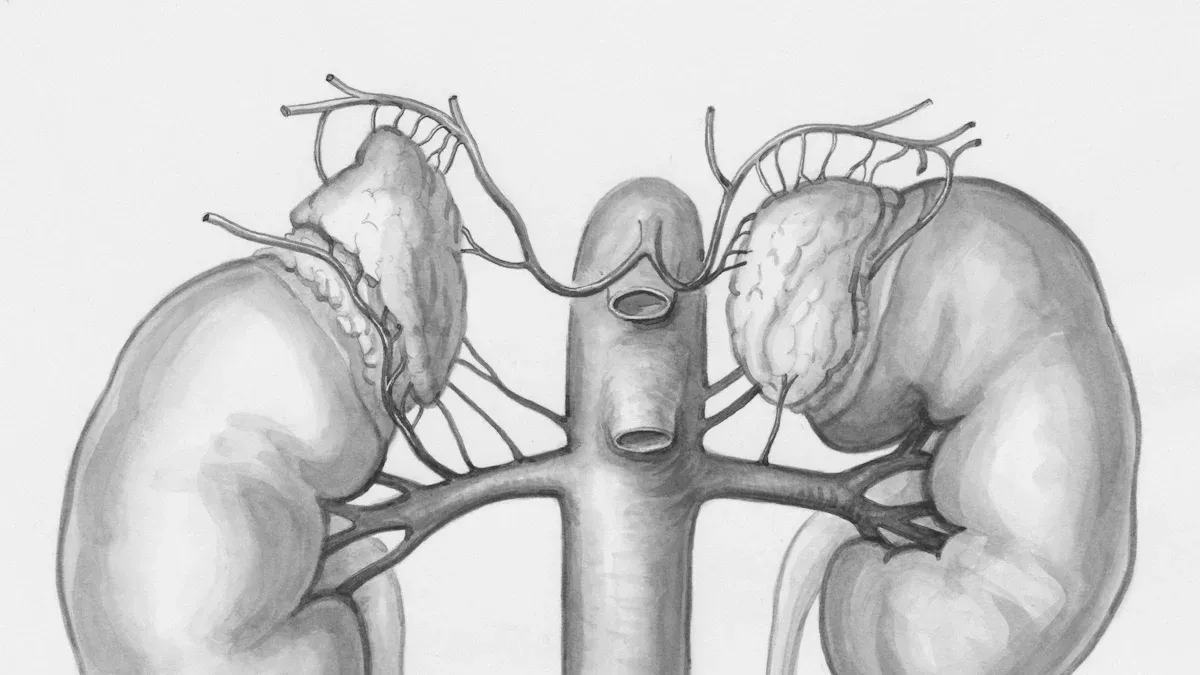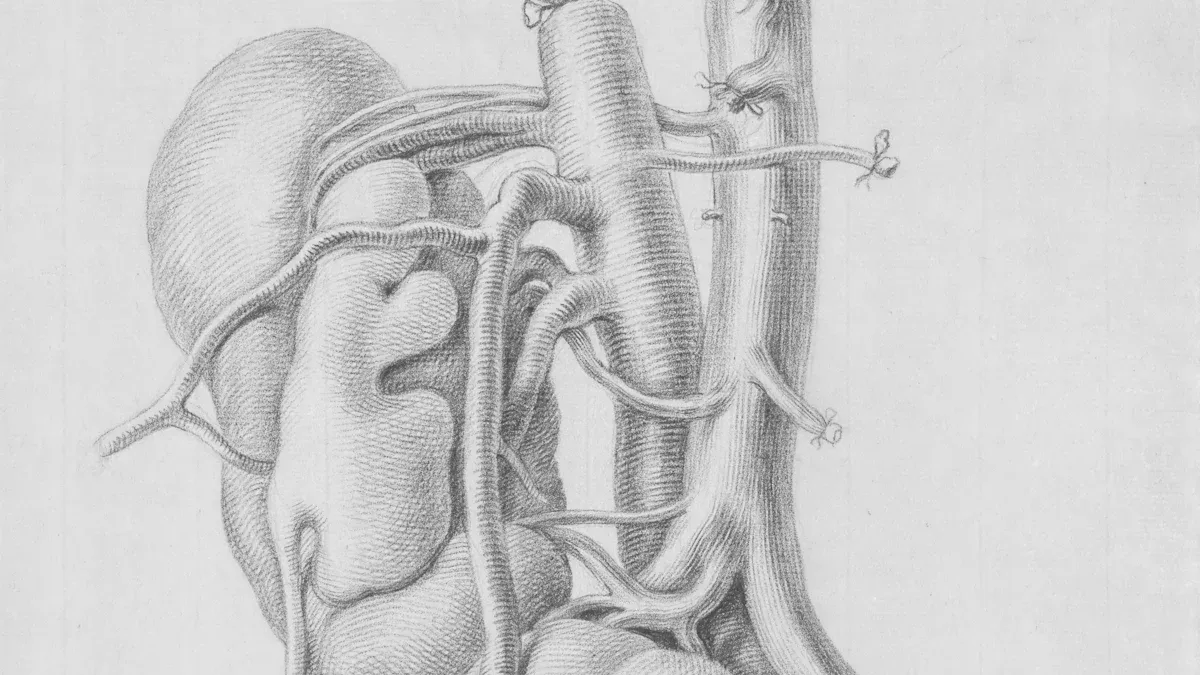What to Know About Adrenocortical Carcinoma Symptoms

Adrenocortical carcinoma is a rare cancer that affects the adrenal glands, small organs located above your kidneys. This condition is very rare in children and also very uncommon in adults, with only a few cases per million people each year. You might notice symptoms caused by hormonal imbalances, such as weight gain, muscle weakness, or high blood pressure. Physical signs like abdominal pain or a feeling of fullness can also appear. In some cases, you may experience fatigue or general weakness. Recognizing these symptoms early can help you seek medical attention and improve your chances of effective treatment.
Key Takeaways
Adrenocortical carcinoma can upset hormones, causing weight gain and weakness. It may also lead to high blood pressure. Spotting these signs early is important to get help.
Physical signs like belly pain, sudden weight changes, or stretch marks might mean adrenocortical carcinoma. Watch for these signs and get checked quickly.
Finding the disease early makes treatment work better. If symptoms don’t go away, see a doctor to check for serious problems.
Knowing the stages of adrenocortical carcinoma shows how it grows. Tumors that stay in one spot are easier to treat, so early discovery matters.
Regular doctor visits and knowing the symptoms can help find the disease sooner. This leads to better care and treatment.
Symptoms of Adrenocortical Carcinoma

Hormonal Symptoms
Excess cortisol production (Cushing’s syndrome)
When your adrenal glands produce too much cortisol, you may develop Cushing’s syndrome. This condition often causes weight gain, particularly in the face, neck, and trunk. You might notice a round, red face or experience muscle weakness. High blood sugar and blood pressure are also common. These symptoms occur because cortisol regulates how your body uses protein, fat, and carbohydrates.
Excess androgen or estrogen production
Adrenocortical carcinoma can lead to an overproduction of sex hormones like androgens or estrogens. In women, excess androgens may cause facial hair growth, acne, balding, or a deepened voice. Men with excess estrogen might experience breast tissue growth, lower sex drive, or impotence. Irregular menstrual periods or vaginal bleeding in postmenopausal women can also signal hormonal imbalances.
Aldosterone overproduction (causing high blood pressure and low potassium)
Excess aldosterone can disrupt your body’s balance of water and salt. This may result in high blood pressure, frequent urination, and muscle cramps. You might feel unusually thirsty or weak due to low potassium levels.
Physical Symptoms
Unexplained weight gain or loss
Sudden changes in your weight, whether gain or loss, can be an early sign of adrenocortical carcinoma. These changes often stem from hormonal imbalances caused by the tumor.
Muscle weakness and fatigue
You might feel unusually tired or weak, even without strenuous activity. This general weakness is a frequent complaint among patients.
Abdominal pain, fullness, or a palpable mass
A tumor in the adrenal gland can cause discomfort in your abdomen or flank. You may feel a sense of fullness or even detect a mass in your abdomen.
Pink or purple stretch marks on the skin
Stretch marks, particularly on your abdomen, thighs, or arms, may appear due to rapid weight gain or hormonal changes.
Increased hair growth (especially on the face in women)
Women might notice fine hair growth on their face, upper back, or arms. This occurs when the tumor causes an overproduction of testosterone.
General Symptoms
Loss of appetite
You might lose interest in eating, which can lead to unintentional weight loss.
Nausea or vomiting
Digestive issues like nausea or vomiting are common, especially as the tumor grows.
Back pain or discomfort
Pain in your lower back or flank area may indicate the presence of a tumor pressing on nearby tissues.
Rounded face with pudgy cheeks ("moon face")
A moon-shaped face with puffiness in the cheeks is a hallmark of Cushing’s syndrome. This symptom results from excess cortisol production.
Note: If you experience any of these symptoms, consult a healthcare provider promptly. Early detection of adrenocortical carcinoma can improve treatment outcomes.
Stages of Adrenocortical Carcinoma

Understanding the stages of adrenocortical carcinoma can help you grasp how the disease progresses and what each stage means for treatment and prognosis. Experts classify the stages based on tumor size, local invasion, and whether the cancer has spread to lymph nodes or distant organs. Two widely used systems for staging include the American Joint Committee on Cancer (AJCC) and the European Network for the Study of Adrenal Tumors (ENSAT). These systems evaluate three key factors:
Tumor (T): The size of the tumor and whether it has invaded nearby tissues.
Nodes (N): Whether the cancer has spread to nearby lymph nodes.
Metastases (M): Whether the cancer has spread to distant organs or tissues.
Stage I
In Stage I, the tumor remains small and confined to the adrenal gland. According to the AJCC and ENSAT systems, the tumor measures 5 centimeters or less in diameter, with no invasion of surrounding tissues. There is no evidence of lymph node involvement (N0) or distant metastasis (M0).
Stage | TNM Classification | Description |
|---|---|---|
I | T1, N0, M0 | Tumor ≤5 cm, no extra-adrenal invasion, no lymph node or distant spread. |
Stage II
Stage II occurs when the tumor grows larger than 5 centimeters but still remains localized to the adrenal gland. Like Stage I, there is no lymph node involvement (N0) or distant metastasis (M0).
Stage | TNM Classification | Description |
|---|---|---|
II | T2, N0, M0 | Tumor >5 cm, no extra-adrenal invasion, no lymph node or distant spread. |
Stage III
Stage III marks a more advanced phase of adrenocortical carcinoma. At this stage, the tumor may invade nearby tissues or spread to regional lymph nodes. Lymph node involvement, classified as N1, indicates that cancer cells have reached nearby nodes. This progression often impacts treatment options and prognosis.
Note: Early detection of lymph node involvement can improve outcomes. If you notice symptoms like abdominal pain or a palpable mass, consult your doctor promptly.
SEER Stage | Description | 5-Year Relative Survival Rate (RSR) |
|---|---|---|
Localized (Stages I & II) | No spread outside the adrenal gland. | 73% |
Regional (Stage III) | Spread to nearby lymph nodes or tissues. | 53% |
Stage IV
In Stage IV, adrenocortical carcinoma becomes more aggressive and spreads to distant parts of your body. This stage is also known as metastatic cancer. The tumor may invade vital organs, making treatment more complex. Common sites of metastasis include:
Lung
Liver
Peritoneum
Bones (less common)
Major veins (less common)
At this stage, symptoms often intensify. You might experience severe abdominal pain, significant weight loss, or extreme fatigue. Breathing difficulties or jaundice could develop if the cancer spreads to your lungs or liver. These symptoms can disrupt your daily life and require immediate medical attention.
How Symptoms Progress by Stage
Early stages may have mild or no symptoms.
In the initial stages, you might not notice any changes in your health. Small tumors confined to the adrenal gland often remain asymptomatic. If symptoms appear, they are usually mild, such as slight weight gain or fatigue. Regular health check-ups and diagnostic tests can help detect the disease early.
Advanced stages often present severe and systemic symptoms.
As the cancer progresses, symptoms become more pronounced and systemic. You may experience high blood pressure, heart palpitations, or hormonal imbalances. Severe weight loss, muscle weakness, and abdominal discomfort are also common. Monitoring these symptoms is crucial for managing the disease.
Description | |
|---|---|
Blood tests | Used to check hormone levels. |
Urinalysis | Measures hormone levels in urine to detect abnormalities. |
Biopsy | Confirms if a tumor is cancerous by examining tissue samples. |
Twenty-four-hour urine test | Collects urine for 24 hours to measure cortisol or 17-ketosteroids, indicating adrenal disease. |
Blood chemistry study | Analyzes blood samples for abnormal levels of substances indicating disease. |
CT scan | Produces detailed images of the body to identify tumors. |
MRI | Uses magnets and radio waves to create detailed images of internal organs, particularly the abdomen. |
PET scan | Detects malignant tumor cells by highlighting areas of high glucose activity in the body. |
These diagnostic tools help track the progression of adrenocortical carcinoma and guide treatment decisions. Early intervention remains key to improving outcomes.
When to See a Doctor
Recognizing Concerning Symptoms
Adrenocortical carcinoma can cause a range of symptoms that may seem unrelated at first. Paying attention to these signs can help you recognize when it’s time to seek medical advice.
Persistent hormonal imbalances, such as unexplained weight gain in the face, neck, or trunk, might indicate a problem.
Physical changes, like abdominal pain, a lump in the abdomen, or a feeling of fullness, are key warning signs.
You might notice increased hair growth on your face, upper back, or arms.
Other concerning symptoms include muscle weakness, high blood pressure, or frequent urination.
Tip: If you experience a combination of these symptoms, don’t ignore them. Early evaluation can make a significant difference in your treatment options.
Importance of Early Medical Evaluation
Early detection of adrenocortical carcinoma improves your chances of successful treatment. Localized tumors are easier to remove surgically, which is the primary treatment for this condition. High-quality imaging techniques, like CT or MRI scans, have made it possible to diagnose tumors at earlier stages.
Here’s why early evaluation matters:
It allows doctors to identify excessive hormone production, which can serve as a tumor marker.
Imaging tests can detect tumors before they spread to other parts of your body.
Early-stage tumors have a higher chance of being cured through surgical resection.
Note: Delayed diagnosis often happens because adrenal masses are assumed to be benign. If you have persistent symptoms, insist on a thorough evaluation to rule out serious conditions.
By consulting a healthcare provider promptly, you can address symptoms that impact your daily life and improve your overall prognosis.
Adrenocortical carcinoma presents a wide range of symptoms, from hormonal imbalances to physical and general health changes. Understanding its stages helps you recognize the disease's progression and seek timely care. Early detection improves outcomes significantly, as localized tumors respond better to treatments like surgical removal and mitotane therapy.
Stage | |
|---|---|
I & II | Complete surgical removal, with adjuvant mitotane therapy under clinical review. |
III | Surgery, radiation, or chemotherapy combinations, including mitotane and others. |
Timely treatment enhances survival rates, with recent advancements offering hope for better long-term outcomes.
FAQ
What causes adrenocortical carcinoma?
Adrenocortical carcinoma often develops without a clear cause. However, genetic conditions like Li-Fraumeni syndrome or Beckwith-Wiedemann syndrome may increase your risk. Environmental factors and random genetic mutations might also play a role.
Can adrenocortical carcinoma be cured?
Early-stage tumors can often be cured with surgery. Advanced stages may require additional treatments like chemotherapy or radiation. Early detection improves your chances of successful treatment.
How is adrenocortical carcinoma diagnosed?
Doctors use blood and urine tests to check hormone levels. Imaging tests like CT or MRI scans help locate tumors. A biopsy confirms if the tumor is cancerous.
Tip: Regular check-ups can help detect abnormalities early.
Is adrenocortical carcinoma hereditary?
Some cases are linked to inherited genetic syndromes. If you have a family history of adrenal tumors or related conditions, consider genetic counseling to assess your risk.
What are the treatment options for advanced stages?
Treatment for advanced stages may include surgery, chemotherapy, radiation, or mitotane therapy. These approaches aim to manage symptoms and slow cancer progression.
Note: Discuss your options with a specialist to create a personalized treatment plan.
---
ℹ️ Explore more: Read our Comprehensive Guide to All Known Cancer Types for symptoms, causes, and treatments.
